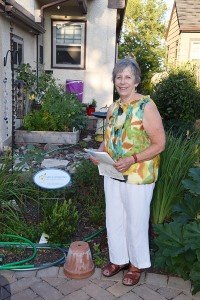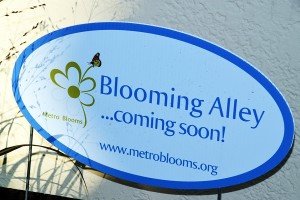By JILL BOOGREN
“Tranquil” isn’t a word that first comes to mind for a place built for parked cars and garbage cans. But it fits for the alley behind Carol Kuechler’s house on the west side of Lake Nokomis. Here, Shenandoah grasses, bee balms, and butterfly weed are planted along back sides of garages. Colorful gardens wrap around fences and walking paths. Some of the driveways are paved in cool designs.
 Photo left: The sign in Carol Kuechler’s garden is another way to let neighbors know what’s blooming. (Photo by Jill Boogren)
Photo left: The sign in Carol Kuechler’s garden is another way to let neighbors know what’s blooming. (Photo by Jill Boogren)
It’s Better Homes, Alleys, and Gardens, and every bit as inviting as a nearby park bench.
It’s pretty with a purpose. Kuechler’s block is among those included in Metro Blooms’ Lake Nokomis Blooming Alleys Project, which works to minimize stormwater runoff—and thereby pollution—into Lake Nokomis by transforming alleyways.
“Not only does the majority of runoff come from there, but it’s also the most polluted,” said Laura Hurley, director of environmental programs for Metro Blooms. Water comes off of garages, backyards, and driveways, carrying with it pet waste, fertilizer, oil, sediment, and salt, she explained. “Anything your car is bringing in is being washed into the alleyway.”
There are a number of ways to lessen that flow such as adding or redirecting downspouts so water pours into lawns and gardens instead of down the alley. You can create rain gardens that can take in large amounts of water then filter it slowly back into the ground. Or, you can install “permeable” paving stones for driveways that allow water to soak through. All of these options reduce the amount of water that gushes down the alley and into our lakes and creek when it rains.
Last year, the first demonstration alley was completed between 16th and 17th Avenues, from 50th to 51st St. Now, with help from the Clean Water Legacy Fund, the program will extend to 15 blocks by 2018. Three blocks (including Kuechler’s) are being installed this year, and several more have signed up.
To participate in the program, 30% of homeowners on a block need to sign on. They first go to an “alley party,” at which Metro Blooms describes the project and shares possible solutions and design ideas. After that, design consultations—which are done at no cost to homeowners—are scheduled. Once costs are finalized, installation can begin. The work isn’t free, but because each Blooming Alley involves a lot of little jobs in one spot, costs are lower. Each household can expect to pay approximately $350-650, depending on work chosen, and anyone wishing to include additional work can take advantage of the reduced rates.
 And because neighbors are working with neighbors, they can choose projects that cross property lines. While touring the alley, Kuechler pointed out a trench drain—a below-grade channel topped by a metal grate—that diverts water from a garage to a rain garden next door. Another resident’s permeable (soak-through) pavers were set next to their neighbors’ rain garden, to help capture excess water.
And because neighbors are working with neighbors, they can choose projects that cross property lines. While touring the alley, Kuechler pointed out a trench drain—a below-grade channel topped by a metal grate—that diverts water from a garage to a rain garden next door. Another resident’s permeable (soak-through) pavers were set next to their neighbors’ rain garden, to help capture excess water.
According to Hurley, about 60% of the water on a typical residential property drains to the alleyway. Their aim is to capture 90-100%. Hurley estimates that once all 15 Blooming Alleys are installed these projects will capture and infiltrate over 100,000 gallons of runoff in a 1” rainfall.
An added benefit is the ability to replace concrete with wildlife habitat. Rain gardens are usually planted with native plants whose long root systems, once decayed, create deep channels for water to flow through. They also tolerate both wet and dry conditions, enabling them to create critical pathways for bees, birds, butterflies, and other pollinators.
“It’s about creating a connected corridor, rather than little patches,” said Hurley. “Insects and pollinators need to move.”
Water and wildlife may be worth working for, but a big draw for participants has been the opportunity to collaborate on a project with their neighbors.
“It’s all very community centered,” said Hurley. “It’s been an awesome way for people to get to know their neighbors.”
As a master water steward (a program introduced three years ago by the Freshwater Society and Minnehaha Creek Watershed District: think master gardener for clean water), Kuechler must complete volunteer hours —both in-the-ground and doing outreach—in order to retain her certification. She appreciates the collaboration across neighborhoods and communities. At the end of the alley tour, a neighbor walking her dog noticed the sign that reads, “Blooming Alley coming soon,” stopped, and said she was very interested. One more connection made.
“It’s all about community engagement,” Kuechler said. “I’ve connected with some people who’ve been very enthusiastic, many people who care about the future of our water.”
Over on the east side of Lake Nokomis another Blooming Alley may be sprouting. Landscape Architect Emily Bujold is working with Christina Schmitt and Miriam Eason, master water stewards in training, to design a rain garden in her front yard. Bujold’s is an alley house, set farther back from the sidewalk.
“It’s a lot of lawn, ‘green concrete,’” said Bujold, referring to the relatively impervious nature of sod. “As a landscape designer I’m obviously real conscious. I wanted to improve [it].” Her rain garden will feature native sedges, milkweed, and blazing star.
Having none of the holding ponds seen to the south and west of the lake, the east side is key for reducing runoff higher up. Bujold plans to have her rain garden complete in time for the Monarch Festival then use it to galvanize support for more Blooming Alleys.
 Rain garden workshops are scheduled for Sat.-Sun., Aug. 29-30, and Sat. Sept. 5 (a backup “rain day” will be Sun., Sept. 6), from 8:30am-1pm, at 4909 28th Ave. S. Bring shovels and garden gloves and help install a rain garden and French drain. You are also invited to stop by on your way to the Monarch Festival to celebrate the new garden and learn about how rain gardens help Lake Nokomis and support butterflies. Sat. Sept. 12, 10am-noon, at 4909 28th Ave. S.
Rain garden workshops are scheduled for Sat.-Sun., Aug. 29-30, and Sat. Sept. 5 (a backup “rain day” will be Sun., Sept. 6), from 8:30am-1pm, at 4909 28th Ave. S. Bring shovels and garden gloves and help install a rain garden and French drain. You are also invited to stop by on your way to the Monarch Festival to celebrate the new garden and learn about how rain gardens help Lake Nokomis and support butterflies. Sat. Sept. 12, 10am-noon, at 4909 28th Ave. S.
Blooming Alleys is a collaboration between Metro Blooms Lake Nokomis Neighbors for Clean Water, Hennepin County, Minnehaha Creek Watershed District, and Master Water Stewards. For more info. contact Laura Hurley at 218-230-4376 or laura@metroblooms.org
Comments
No comments on this item Please log in to comment by clicking here